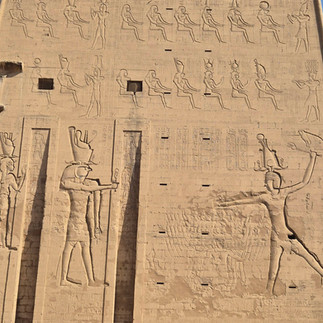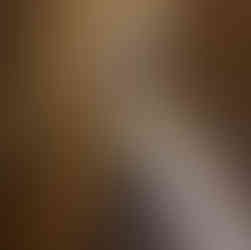Egypt 2025 Part 5 Cruising the Nile
- Anne B 10milesfrom
- Mar 19
- 7 min read

We awoke to find palm trees outside the window and we were still sailing, so had breakfast and went on deck.
Our guide, John had sailed with us and was excellent at keeping us updated with all the timings and pickups, so we were in time to watch our large ship go under a very low bridge. Flags, umbrellas and the bar roof had all been taken down, and you could touch the bridge as we went under... well, maybe Penny and I couldn't quite!! Then the sailor clad crew swung into action and it was all back to normal in minutes!

We docked alongside 2 other ships, so to reach shore you walk through them!
There are a lot of cruise boats all using the same ports. Sometimes we saw as many as 6 moored alongside each other. We had just one visit today, the Temple of Horus. As we docked, scores of horsedrawn caleche carriages came to the boat. Our guide explained that we would be going by car, as a few years ago his company had decided to stop using them due to concerns about the welfare of the horses, and poor safety record due to accidents where wheels fell off! We were glad to go by car, and even more so when we saw the poor horses, rickety carriages and wobbly wheels.
The temple was just 10 minutes away, and was different again. Every day produces new and interesting places. The temple of Horus is a relative newbie, started in 247BC when the Greeks were ruling Egypt. They embraced the Egyptian Gods and building style, and even tried to weave themselves into it. The first building you encounter is a birth house, where inscriptions suggest that Ptolemy was directly descended from the Egyptian God Amun-Ra! Was this to make him seem a more acceptable ruler to the Egyptians, or was he hedging his bets?!
The main buildings follow the pattern of all Egyptian temples. This one was built on the site of a much older temple, and some of the old walls are still here.
Now for some Egyptian mythology. Buckle up!
Osiris, God of kingship and the afterlife, married Isis. His brother Seth was jealous and killed Osiris, chopping him into pieces. Isis found the pieces and assembled them using magic so Osiris became God of the afterlife. Their son Horus fought many times with Seth to avenge his father and claim the throne.
Horus eventually killed Seth, but Horus' eye was injured. This was restored by Thoth, God of wisdom, and the Eye of Horus became a symbol of protection and healing and was adopted and adapted by Greek and Arab civilisations.
Any Only Connect fans reading?
These stories of Horus, Seth, Osiris and Isis are depicted all over the temple.
Horus is often depicted as a falcon, or with a falcon head.
This temple was buried in sand for many years and is very well preserved, although many figures have been defaced by the early Christians, seeing it as pagan worship. All around the temple is a huge protective wall. Inside this is a passageway, intricately decorated with panels depicting Horus defeating Seth.
Seth is depicted as a Hippopotamus. A dangerous creature, notoriously difficult to hunt and kill, this showed the might of Horus because he eventually achieved it. The pictures also show that this is Seth getting his just desserts for daring to kill Osiris and were designed to be a warning against doing wrong. Here Horus is standing on a large Hippo - the defeated Seth who was a great challenge!

The huge pylons show Ptolemy beating his enemies and offering them to Horus. Inside, the pillars are in good condition and there is a roof over much of the temple. The sanctuary is also quite complete.
Each God had a symbolic boat which was kept in the sanctuary or barque room. This is a replica of Horus' boat. His wife was Hathor, the cow Goddess we have met before. Her main temple was at Dendara, over 100 miles down the Nile. Once a year, her boat and statue would be brought down the Nile to Edfu and the 2 boats would process side by side to the sanctuary where they would stay together for 3 months. It was called the festival of Divine Reunion. John explained that the temple priests everywhere tried to create new festivals so people brought more money and offerings to their temples! There were 2 routes to the roof... a Horus statue would be taken up a spiralling staircase on one side to represent soaring upwards on the thermals, and down a straight ramp on the other as he swoops straight down on his prey!
There were also images of King Ptolemy. A huge series showed him completing the 4 stages of temple building. This is the final stage, scattering salt around the outside of the temple, shown as a plan, to sanctify and protect it.

Archeologists as recently as last year discovered evidence of the rich colours the temple would have been decorated in, and also that all the statues would have been gilded and shiny! Wow! This was an amazing temple!

In my father's photo album there were lots of dogs. We also saw feral dogs everywhere! They seemed to be a similar breed, and here there were 2 packs having a stand off. This was the 'In the temple' pack! Keep out was definitely the message!

Edfu is well off the main tourist trail and as we headed back to the ship we felt we were really seeing Egypt.There is obviously a great deal of poverty in the country, and the gap between rich and poor is widening.

Once again we are humbled by people's cheeriness in the face of very hard living and working conditions. No wonder they ask for Backsheesh, a tip. We must look like millionaires. We are so lucky. Penny and I have tried to tip generously and frequently, but sadly you cannot tip everyone. But Egypt wants and needs tourists, and by using local tour companies and guides it really does help.
Back on our boat... not a super Luxury model by any means despite appearances, but comfortable and functional, we are greeted with smiles and hellos from every member of staff we pass. (Every cruise ship on the Nile is called Luxury 5 star.... most are not! Ours was a solid 3 stars!)
Our afternoon was spent sailing down the Nile passing almost biblical scenes. Barefoot fishermen, children playing in the river, cattle grazing by the water and birds in the lagoons. And always the vast desert, sometimes just metres behind the narrow strip of green bordering the river.
We passed Gebel Silsilah, a sandstone quarry dating back thousands of years, containing some burial chambers and a temple. Apparently there is evidence of very early settlement here, and there are cave drawings of these giraffes dating back at least 7000 years. (Not my photo!)

The sailing was lovely. We would highly recommend a Nile Cruise as part of a visit to Egypt. We even ventured to the pool! Penny swam lengths!!

Our lovely room stewards had fun with the towels today.....
Egyptian temples were all sites of pilgrimage, and the Nile was the transportation system, so it is fun being on a ship following some of their routes.

That evening we arrived at the small town of Kom Umbu. We had arrived after dark, so a quick dinner and then we met John to walk to the temple here. Kom Umbo definitely seemed a more edgy place, although being dark probably didn't help! Hawkers were all along the front offering us scarves, pyramids, books, alabaster dishes and many other items... all with the perennial cry of "Just one dollar". Of course, if you stop and show an interest, the one you want is considerably more than $1! However having John with us was amazing. One word from him and they melted back into the darkness to pursue the next tourist. However, their town is literally miles from anywhere. Work opportunities are few, so when the boats come in they have to seize the moment to make some money! The temple here is different again. It sits up high, and has been badly damaged over the years, mainly due to the Nile floods. Although it seems high up above the water, before the Aswan dam was built the floodwater could come metres up it's walls! By now, it was completely dark, so the temple was illuminated which was beautiful.

An almost full moon overhead made the scene quite magical. This temple is unique. Built 2,200 years ago under Ptolemy's Greek rule, it has 2 of everything side by side, and is 2 temples. One side is dedicated to Horus the falcon headed God, and the other to Sobek, God of Fertility and creation and represented by a Crocodile.

It has some interesting carving and reliefs, including this one showing a 2,200 year old set of surgical implements, many of which are designs still in use today.

The pillars and ceilings were even more striking against the night sky.
Kom Umbo temple also has 3 special features that we haven't encountered before. Two of the walls are covered in hieroglyphics which, when read, are one of the earliest known written calendars. The Festival calendar. A week was 10 days, and each month had 30 days. So, at the end of the year they had 5 days to spare, which they spent celebrating before the planting season began. They had just three seasons, Harvest and the Flood were the other two.


Also here was a pit in the ground with a stairway down. This was the Nile-ometer.

Records would be kept of the height of the river each day, and these would be used to predict when the flood would start and how high it might reach. Finally, the crocodile basin.

As this temple was dedicated to Sobek, the crocodile God, a live crocodile would be kept virtually as a pet. When it died, it would be embalmed, mummified and given a proper burial. Crocodile tombs were found under the site.We saw evidence of this in the little crocodile museum next door.

Back to the boat and off to bed... alarm set for 03.55! Poor Penny...although she has coped very well with all the early starts! We sailed through the night to Aswan in the south of Egypt.





















































































































Thank you for bringing back great memories of our nule cruise, especially the full moon in Kom Ombo. Magical indeed.